 Tank of the Month
Tank of the Month
Tank of the Month
Dan Rigle's (rigleautomotive) Reef Aquarium
 |
Introduction
My name is Dan Rigle and I am honored to be a part of the Reef Central community. I have learned so much from being a part of it. I feel privileged to be chosen as Tank of the Month, and this is well above my wildest expectations. I used to absorb every bit of knowledge from the pages of FAMA and other printed publications before the Internet was readily available, so I can really appreciate the information at hand now that's available for free. As a guy that started out almost 20 years ago in this hobby I have found that having the ability to talk to many experts at the stroke of a key is a dream come true. I just want to thank all the moderators, geniuses, chemists, doctors etc… for teaching me so much. Guys like Randy Holmes-Farley, Sanjay Joshi, Boomer, Genetics, along with a countless number of gurus from various expertises at your request is what makes Reef Central great and the best source for cutting-edge information and true science.
Background
Keeping a reef tank became much more of an obsession than I ever realized possible. I started keeping low light corals like Zoanthids and Actinodiscus spp. early on, which proved quite easy for me. These not only stayed alive but reproduced and thrived with very limited lighting and equipment. At that point I was hooked, but it wasn’t until I became addicted to Acropora species that I realized I was not the master I envisioned! I found that these animals were much more sensitive than the previous ones I had kept. After years of reading (and a very slow learning curve) I was finally able to keep Acropora spp. living long-term. One becomes very in tune with their coral reef when learning what they require to thrive and unconsciously making tiny adjustments to suit their health needs. I am a firm believer that careful, daily observation is one of the most important things one can do. If you observe each and every coral carefully each day, you can almost feel when a parameter is out of specification. Testing is great but perfect chemistry does not equal a thriving SPS tank in all instances. I have tinkered with several methods of nutrient control, namely bacteria dosing and GFO medias, and found my way back to my old school method; refugium with macroalgae harvested monthly, large water changes (20% weekly) and heavy wet skimming. I feel it is a gentler method of phosphate and nitrate control while providing a more natural environment with some measurable phosphate and nitrates and microbial life (pods etc…) in abundance. Whereas the several times I experimented with bacteria dosing I achieved somewhat lighter coloration, some would say better coloration, along with unmeasurable phosphate and nitrates. However, both times I attempted this it took my levels down too low and I observed negative results. I am sure for some aquarists with the right systems it can be done with great success but I feel I had better success with my old school system so I returned to the refugium method.
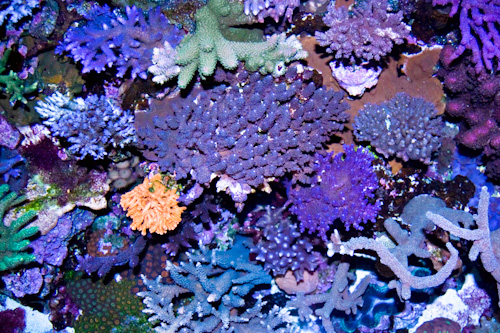 |
Current Tank, Concepts, and Philosophy
The tank is an All-Glass 180 US gallon MegaFlow. I really enjoy building things, so I constructed a custom DIY canopy and sump. The canopy was built to house three Lumenarc Mini reflectors and two 6’ VHO actinic supplements. Radium 20,000K metal halide bulbs are used and driven by ARO electronic ballasts. The VHO actinics are driven by an IceCap 660 Ballast. The sump was built to accommodate the ETSS 600 Pro skimmer and a small 2’ x 2’ refugium. I custom built the sump from ¼ inch acrylic to utilize all available space under the cabinet and maximize total water volume in the system. Flow is provided by two Tunze 6105 pumps on a Tunze multicontroller and a closed loop driven by a Blue Line 40X HD fitted with four Penductors on the outlets with a Squid switching device. This approach creates many random flow patterns with some quiet time between bursts of powerful flow. Using an ETSS downdraft skimmer required a fairly high flow though the sump so a Blueline 40 HD is used for a return pump, supplying about five times per hour turnover. This skimmer also works best with a constant water level on the skimmer side of the sump so a baffle was included to keep it at a constant 6 inches. This skimmer produces around 1 US gallon of skimmate per week. When kept clean and maintained, I believe it can over-skim my tank. Currently, I fill a 55 US gallon drum with RODI and use adjustable dosing pump to keep the tank topped off. Once the dosing pump is adjusted it can go weeks or months without adjustments and there is no chance of overfilling or TDS creep.
As the years went by I became very interested in fragging corals and became passionate about spreading the corals I grew in captivity to as many people as possible. I joined our local reef society, NCPARS, whose mission was right in line with mine. The mission is saving wild corals by propagating and educating the public about coral reefs and conservation. After serving as secretary of the society for a short time I was then elected as vice president and then for the last couple years I have been President of the society. This is the most rewarding job I have ever done and I eagerly volunteer my time and effort to educate the young and new hoping that I can make a small difference. The society has been growing steadily in membership and attendance so I am pleased at the results. I started fragging corals back in the late 1990s with GARF supplying me the information I needed to get started. Back then even super glue gel was hard to get and frag plugs were all home made. Garf was a very informative site in the early days and prior to finding Reef Central it was my favorite reading. I constructed my acrylic sumps from the DIY section of the website.
Since finding Reef Central, I learned an immense amount by reading posts on top of posts for hours daily. It was here I found the DIY plans for my calcium reactor and the reef tank chemistry calculator I use frequently. I also began perfecting my fragging skills and realizing 90% or better survival rates with Acroporas and other sensitive corals. My local pet stores now loved me and store credit was a beautiful thing! This hobby has been so much more to me then just a hobby. I have learned chemistry, math, biology and science because of it; things I never understood while at PSU or had the interest to for that matter. This is why I believe getting the youths involved is so important and keeping a coral reef can be a very positive force in ones life. I love watching children’s eyes when they first peer into my Reef as they try to absorb all the life, color and movement in an instance. NCPARS now has a large successful Tanks in Schools program with many reef aquariums set up in Pennsylvania schools and being funded by the society. I am very proud of this, and glad I was able to put something like this into realization with the help of the NCPARS board of directors and society members. I have met too many awesome people to mention being involved in this hobby and society.
This hobby has been a life changing experience for me and I have been reading and learning every day even after two decades. It truly has forged its way into my life and I am known by friends and family as a self proclaimed expert in marine life. I have found no better stress reliever then staring at the diverse life in a mature reef aquarium. This hobby is like no other in the respect that it never gets old. You never master it to the point it becomes boring, at least it never has for me. Just when you think you have mastered it, an Acropora will RTN for no apparent reason and humble you instantly. I am not saying doing weekly 20% water changes are the high part of my weekend, but I love tinkering and building things so this was right up my alley. The chemistry and science is also very interesting to me, and I have the hobby and Reef Central to thank for my understanding of this.
SANJAY'S DO-IT-YOURSELF (DIY) REACTOR
The calcium and alkalinity is maintained with a DIY reactor I constructed from regular PVC and it is filled with ARM course media. The reactor can be built with clear PVC but I had regular white on hand so I used it and have been running it ever since. Its been approximately six years in operation. Though I cannot view the media to see when it is has been exhausted, I know from experience it needs to be filled at 3 month intervals or when alkalinity become too difficult to maintain. A pH monitor is used to measure calcium reactor effluent. I test alkalinity often and ignore calcium unless I sense a problem. The alkalinity and calcium remain in balance given the reactor method of control. I manually adjust the reactor periodically and do not use the solenoid to cycle the CO2 on and off. This is mainly due to the failures I have encountered with several brands I have tried. In the past the valve would eventually stick open or closed and this was not something I wanted to take a chance on. The reactor may need a bit of tweaking once or twice a month but this keeps me more in tune with the alkalinity and calcium demands.
RANDY'S TWO-PART ADDITIVE
The alkalinity and calcium remain in balance given the DIY reactor. I feel that unless I notice a decline in health or loss of color my phosphates and nitrates are under control. I test magnesium about once a month and add as needed from a gallon of Randy's two-part formula. I believe weekly water changes with Red Sea Coral Pro helps keep trace elements and the like within specification.
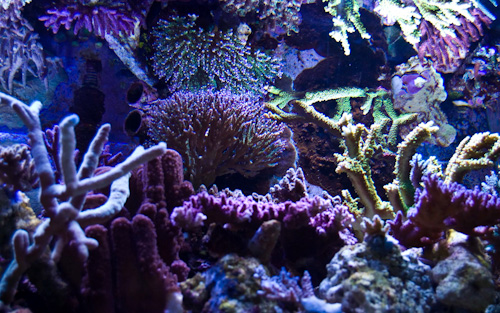 |
System Profile
• Display tank: 180 US gallon (72" x 24" x 24")
• Sump: 56" x 20" x 14" - Custom built for ultra high flow acrylic sump
• Skimmer: AE Tech ETSS 600 Pro Downdraft protein skimmer driven by a Iwalki HD40
• Lighting: 3 Radium 250W metal halides driven by ARO electronic ballasts, 2 VHO 6' actinics on IceCap 660 ballast
• Circulation: Display is powered by a Blueline HD 40X HD on closed loop, 2 Tunze 6105's on a Tunze multicontroller and additional circulation provided by the Blueline 40 HD return pump
• Return Pump: Blue Line 40 HD
• Fresh Water : Supplied by 2x 75 GPD RODI
• Frag Prop Tank: 48" x 18" x 18"
• Frag Prop Tank Lighting: Radium 250W metal halides in parabolic reflectors driven by ARO electronic ballasts
Maintenance and Feeding
My tank is maintained with the incorporation of old school thought when possible. I use strong export means with 20% water changes done weekly and wet protein skimming. The skimmer is cleaned once a week. I also feed pretty heavily along with strong export this system works for me. I run a 100 micron filter sock that is changed twice a week. I use macroalgae in the refugium that I harvest once a month or as needed. I run activated carbon passively in bags in the sump and GFO in a Two Little Fishes reactor.
My feeding consists of a large variety. Nori or seaweed, Omega One flakes, Oyster Feast, Cyclopeeze, brine shrimp, PE mysis and table shrimp. I feed the tank several times throughout the day and adjust feedings according to how my colors appear. If I notice some SPS are browning a bit or darkening, I reduce the amounts of feedings. Subsequently if I notice colors lightening or loss of color in zoos or LPS corals I ramp up the feedings until this starts to return. I am a firm believer the individual that is keeping the reef is much more crucial to its success than an unlimited budget and all high end equipment one could purchase.
Weekly maintenance currently takes several hours with some SPS needing trimming along with the typical tank maintenance. This pruning becomes the most time consuming and I truly must be in the right frame of mind to do this effectively. Trying to propagate delicate animals takes a great deal of patience and care to get acceptable survival rates. This has been my focus the last several years and teaching others how to successfully propagate captive raised corals is my passion. It’s hard to describe in words how important coral reef keeping has become to me but I can tell you that when my reef is not doing well I feel physically sick and will not rest until I get things back to optimal health. Many who know me will agree that I am truly an OCD reef fanatic! Not diagnosed or certified but OCD reef fanatic nonetheless.
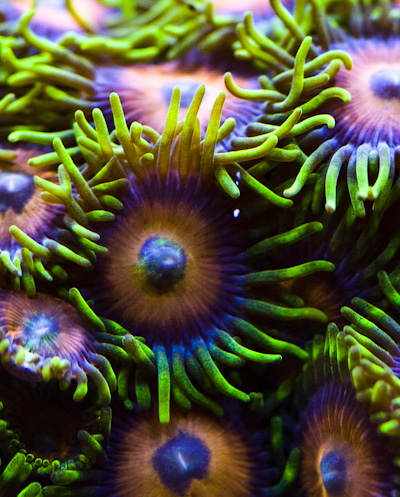 |
Lighting
|
Lighting Schedule:
|
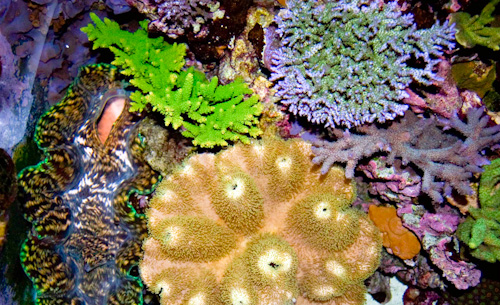 |
|
Water Parameters:
|
Fish and Invertebrates
|
Fish & Invertebrates:
|
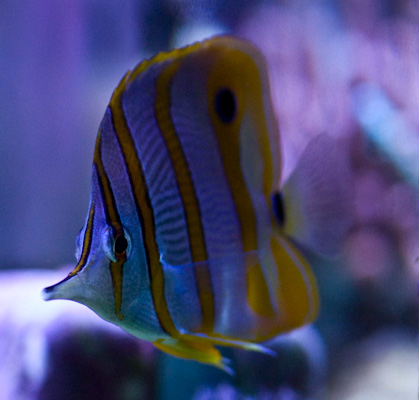 |
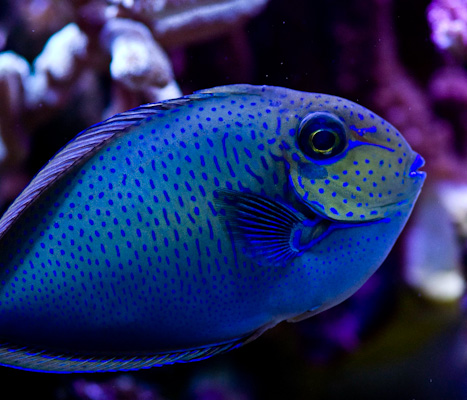 |
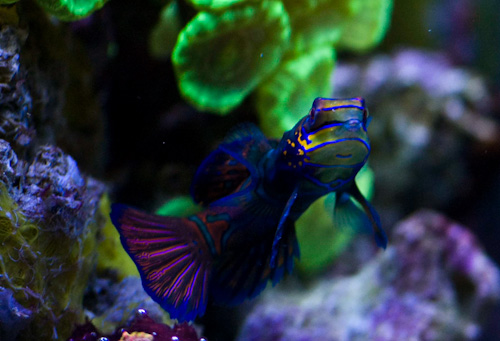 |
Corals
|
Corals:
|
|
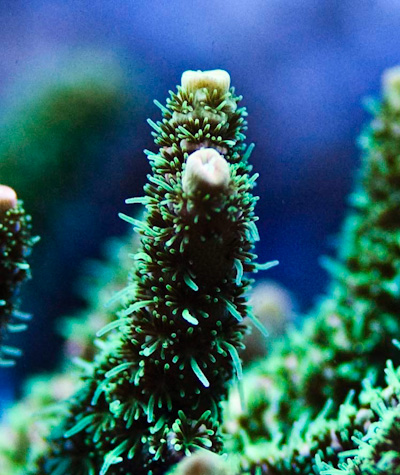 |
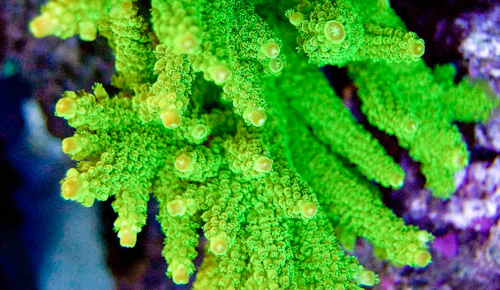 |
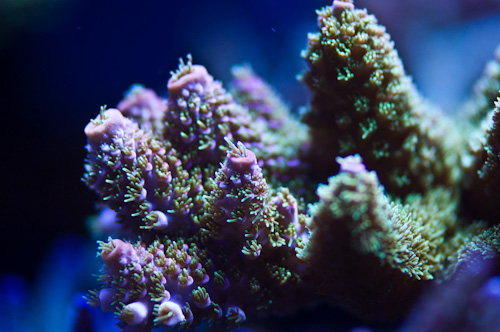 |
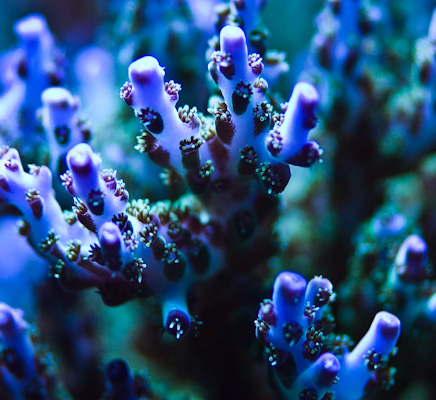 |
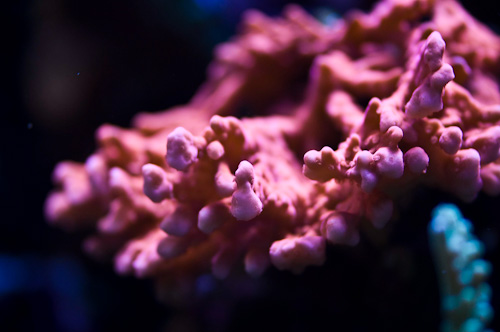 |
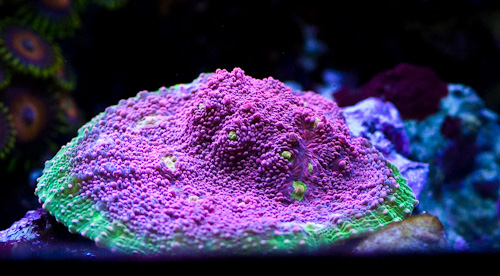 |
Acknowledgements
I would need another issue to acknowledge all the folks that deserve mentioning, but here are a few. I want to thank everyone who nominated me for Tank of the Month, Jon (X2uranium) for starting my tank thread, thanking my wife and family for putting up with my obsession, Reef Central staff and members for being so helpful and informative, and to the North Central PA Reef Aquarium Society for giving me the chance to touch so many people with my quest.
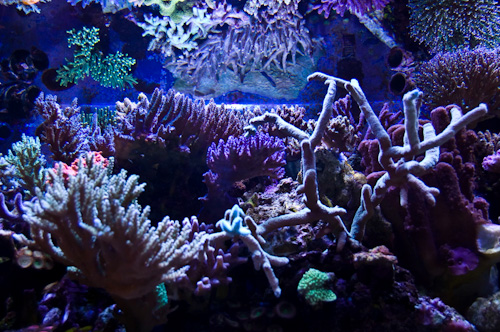 |
Feel free to comment or ask questions about my tank in the Tank of the Month thread on Reef Central.



